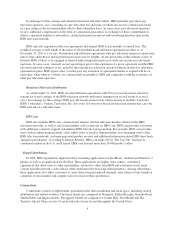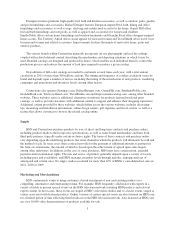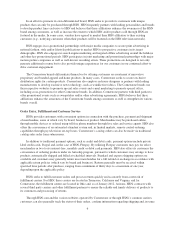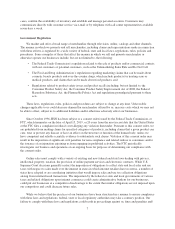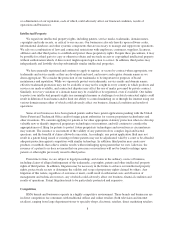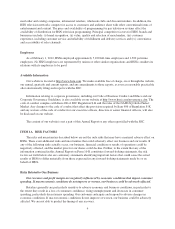Home Shopping Network 2011 Annual Report Download - page 15
Download and view the complete annual report
Please find page 15 of the 2011 Home Shopping Network annual report below. You can navigate through the pages in the report by either clicking on the pages listed below, or by using the keyword search tool below to find specific information within the annual report.businesses from efficiently providing services or fulfilling orders. We also rely on affiliate and third-party
computer systems, broadband and other communications systems and service providers in connection with the
provision of services generally, as well as to facilitate, process and fulfill transactions. Any interruptions, outages
or delays in our systems and infrastructures, our businesses, our affiliates and/or third parties, or deterioration in
the performance of these systems and infrastructures, could impair our ability to provide services, fulfill orders
and/or process transactions. Fire, flood, power loss, telecommunications failure, hurricanes, tornadoes,
earthquakes, acts of war or terrorism, acts of God and similar events or disruptions may damage or interrupt
computer, broadband or other communications systems and infrastructures at any time. In addition, we have
observed an increase in the number of cyber attacks that include gaining access to digital systems for purposes of
corrupting data or causing operational disruption. Any of these events could cause system interruption, delays
and loss of critical data, and could prevent us from providing services, fulfilling orders and/or processing
transactions. While we have backup systems for certain aspects of our operations, these systems are not fully
redundant and disaster recovery planning is not sufficient for all eventualities. In addition, we may not have
adequate insurance coverage to compensate for losses from a major interruption.
Increased delivery costs could adversely impact our profits, particularly if we are unable to offset them by
increasing prices without a detrimental effect on customer demand.
We are impacted by increases in shipping rates charged by various shipping vendors relating to the
procurement of merchandise from vendors and manufacturers, the shipment of merchandise to customers and the
mailing of catalogs, which over the past few years have experienced volatility in comparison to historical levels.
We currently expect that shipping and postal rates will continue to increase. In the case of deliveries to
customers, we have negotiated favorable shipping rates, which increase at agreed upon levels over time, with one
independent, third party shipping company pursuant to a long-term contract. If this relationship were to terminate
or if the shipping company was unable to fulfill its obligations under the contract for any reason, we would have
to work with other shipping companies to deliver merchandise to customers, which could be at less favorable
rates and could cause a disruption in our business. Any increase in shipping rates and related fuel and other
surcharges passed on to us by this or any other shipping company may adversely impact profits, given that we
may not be able to pass these increased costs directly to customers or offset them by increasing prices without a
detrimental effect on customer demand.
We may not be able to accurately predict and/or respond in a timely manner to evolving customer
preferences and trends and industry standards, which could result in excess inventory, related markdowns and
lost sales.
Our success depends, in significant part, on our ability to accurately predict, and respond in a timely manner
to, changes in customer preferences and fashion, lifestyle and other trends and industry standards. While product
mix and price points are continuously monitored and adjusted in an attempt to satisfy consumer demand and
respond to changing economic and business conditions, we may not be successful in these efforts, and any
sustained failure could result in excess inventory and related markdowns.
In addition, the internet industry is characterized by evolving industry standards, frequent new service and
product introductions and enhancements, as well as changing customer demands. If we are not able to adapt
quickly enough and/or in a cost-effective manner to these changes it could result in lost sales.
We could be subject to additional sales tax liability, including liability for past sales.
U.S. Supreme Court decisions generally restrict the imposition of obligations to collect state and local sales
and use taxes with respect to sales made over the internet. However, a number of states, as well as the U.S.
Congress, have adopted or are considering initiatives that would impose sales and use tax collection obligations
arising from digital-based transactions. If these initiatives are successful, we could be required to collect sales
and use taxes in additional states. The imposition by state and local governments of various taxes upon digital
13



